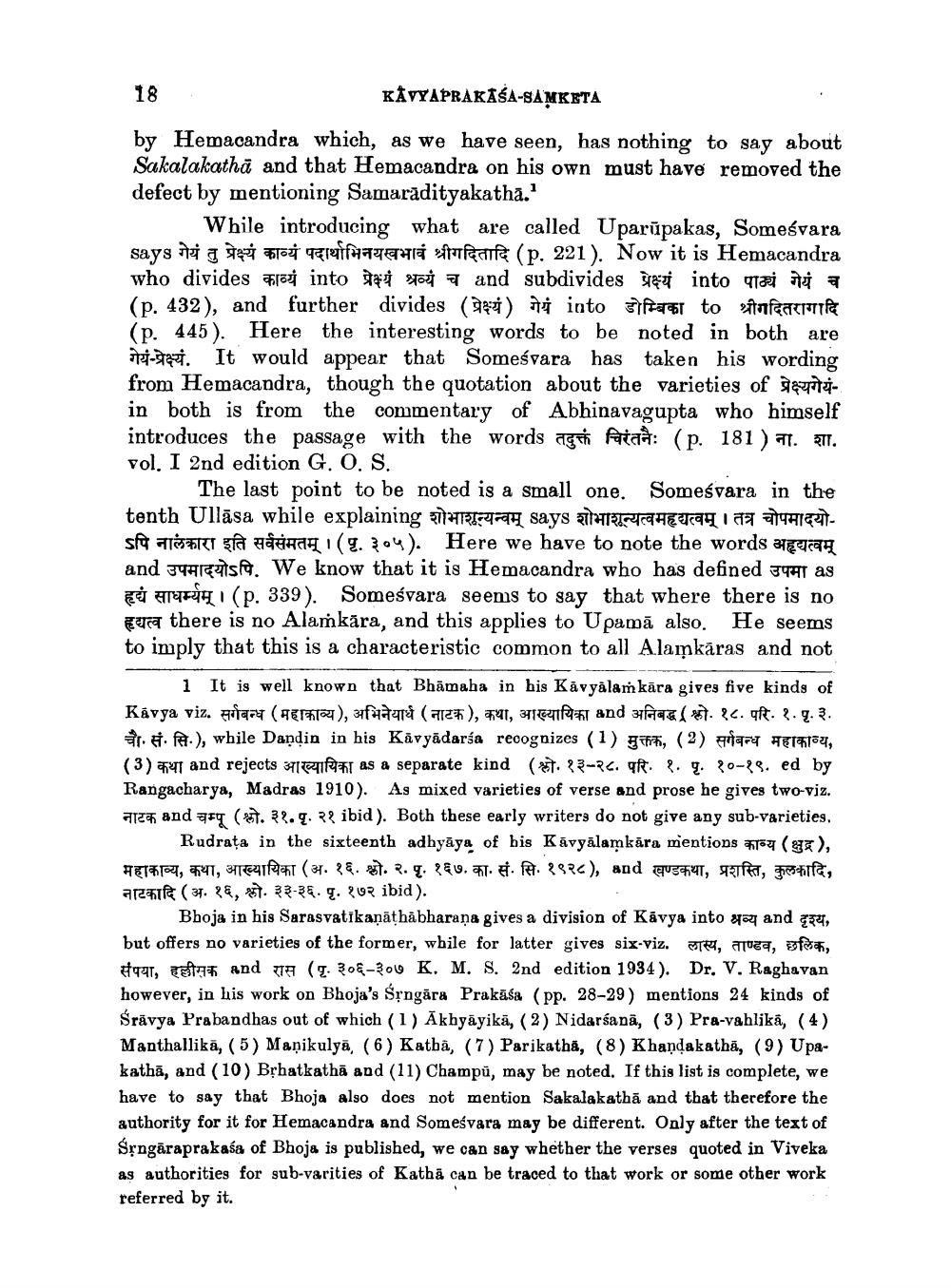________________
18
KÁVYAPRAKASA-SAMKETA
by Hemacandra which, as we have seen, has nothing to say about Sakalakatha and that Hemacandra on his own must have removed the defect by mentioning Samarādityakatha."
While introducing what are called Uparūpakas, Someśvara says गेयं तु प्रेक्ष्य काव्य पदार्थाभिनयखभावं श्रीगदितादि (p. 221). Now it is Hemacandra who divides काव्यं into प्रेक्ष्यं श्रव्यं च and subdivides प्रेक्ष्यं into पाठ्यं गेयं च (p. 432), and further divides (प्रेक्ष्य) गेयं into डोम्बिका to श्रीगदितरागादि (p. 445). Here the interesting words to be noted in both are 772-921. It would appear that Someśvara has taken his wording from Hemacandra, though the quotation about the varieties of genitiin both is from the commentary of Abhinavagupta who himself introduces the passage with the words agat Arad: (p. 181 ) I. II. vol. I 2nd edition G.O.S.
The last point to be noted is a small one. Someśvara in the tenth Ullāsa while explaining 777717494 says RHETY 19 14H121sa at ga adha (g. 304). Here we have to note the words apcan and उपमादयोऽपि. We know that it is Hemacandra who has defined उपमा as
NATIF I (p. 339). Someśvara seems to say that where there is no kura there is no Alamkāra, and this applies to Upamā also. He seems to imply that this is a characteristic common to all Alamkāras and not
1 It is well known that Bhāmaba in bis Kavyalam kāra gives five kinds of Kávya viz. Fara (HET ), fent (afs*), FM, enfant and fas( .9. 2. q. 3. #. # .), while Dandin in his Kāryādaría recognizes (1) , (2) antara #614174, (3) 741 and rejects 311611fh as a separate kind (**.23-26. gr. 9. g. 80-85. ed by Rangacharya, Madras 1910). As mixed varieties of verse and prose he gives two-viz. 772# and art (27. 38.9. 22 ibid). Both these early writers do not give any sub-varieties,
Rudrata in the sixteenth adhyāya of his Kávyālaņkāra mentions #14 (9), HETATA, 41, Tegah (34.28... 9. v. . . . 8920), and EU 4T, cft, rostilla, arcaife ( 34.8, 1. 33-38. q. ibid).
Bhoja in his Sarasvatīkaņāthābharaṇa gives a division of Kāvya into 4 and , but offers no varieties of the former, wbile for latter gives six-viz. tea, Tuca, festa, #991, 2 and 7 (T. 306-306 K M. S. 2nd edition 1934). Dr. V. Raghavan however, in his work on Bhoja's Śrngāra Prakāśa (pp. 28-29) mentions 24 kinds of Śrávya Prabandhas out of which (1) Akhyāyikā, (2) Nidarśanā, (3) Pra-vablikā, (4) Manthallikā, (5) Maņikulyā, (6) Katbā, (7) Parikatha, (8) Khandakathā, (9) Up&kathā, and (10) Běhatkathā and (11) Champú, may be noted. If this list is complete, we have to say that Bhoja also does not mention Sakalakathā and that therefore the authority for it for Hemacandra and Someśvara may be different. Only after the text of Srngāraprakaśa of Bhoja is published, we can say whether the verses quoted in Viveka as authorities for sub-varities of Kathā can be traced to that work or some other work referred by it.




